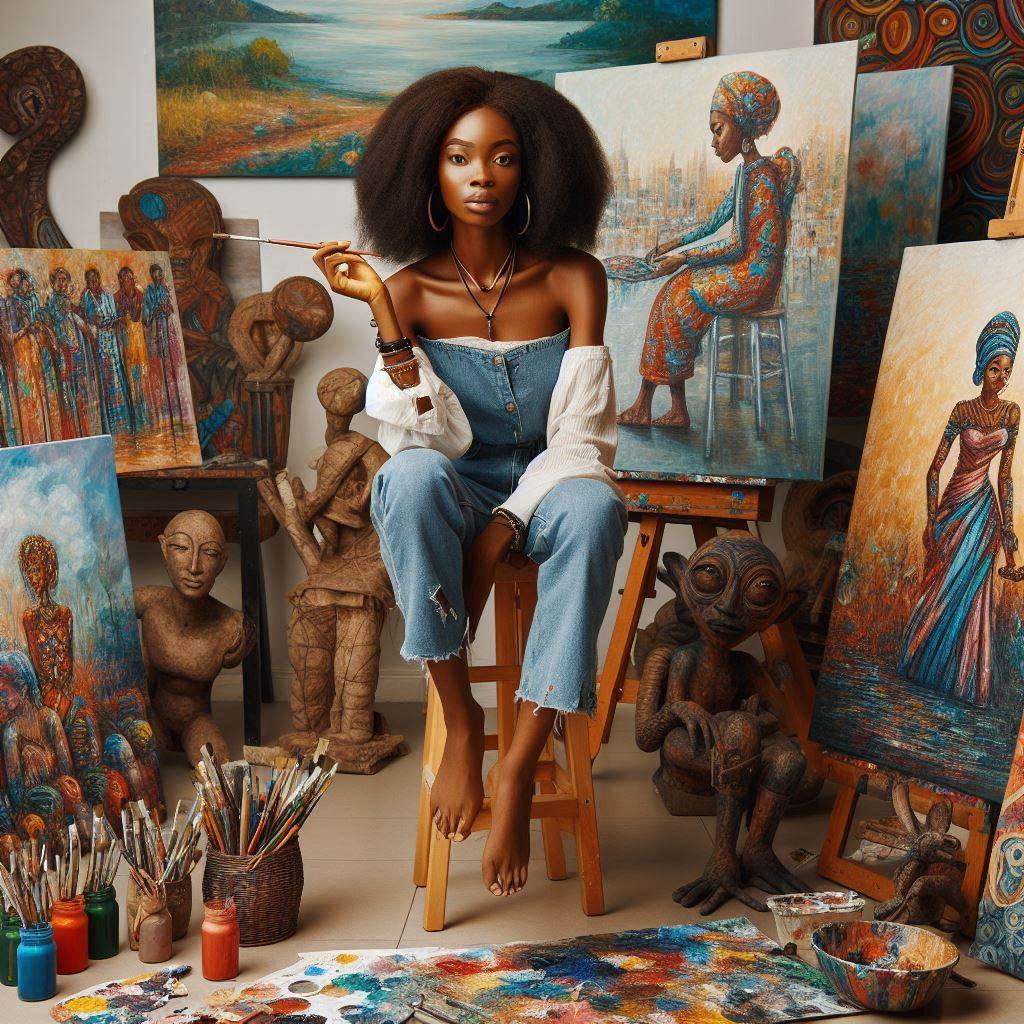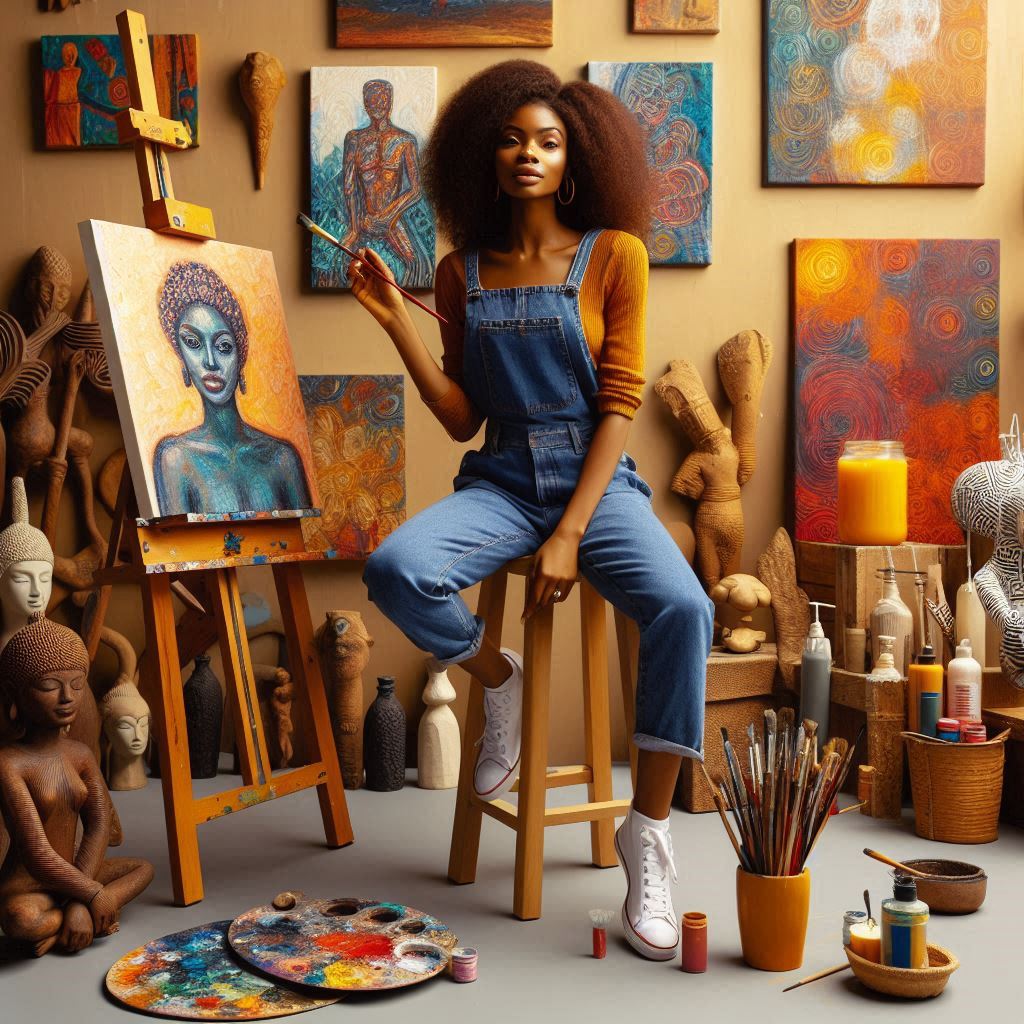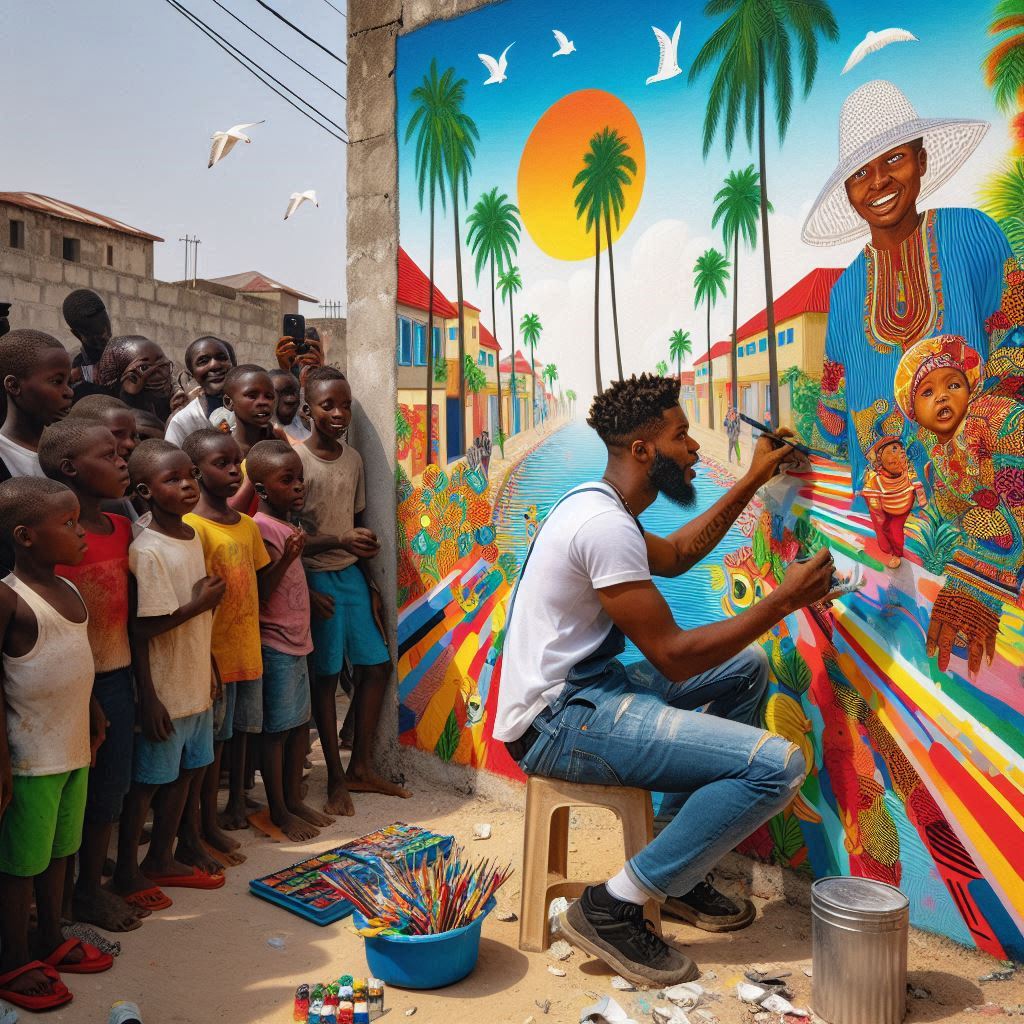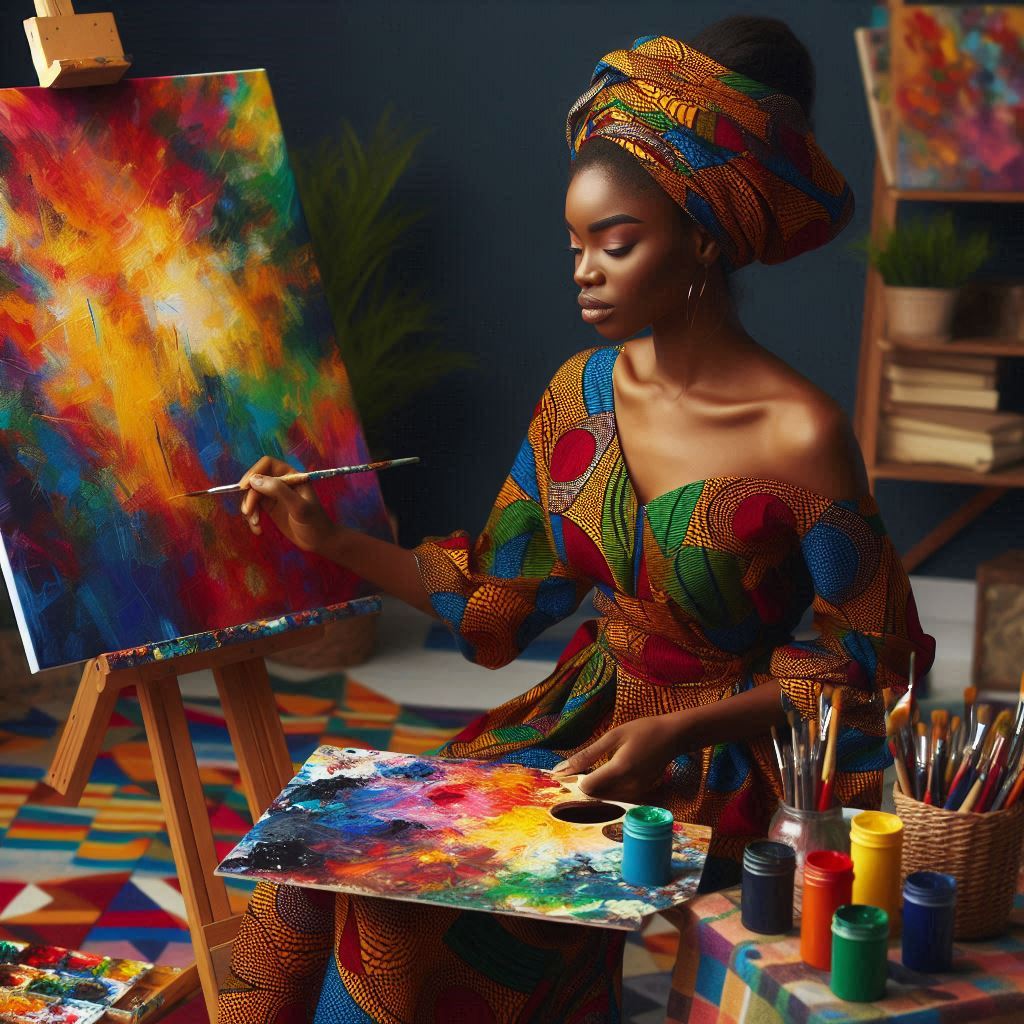Introduction
Nigeria, a country renowned for its rich cultural heritage, stands as a testament to the diversity and complexity of human expression.
Within its borders lie centuries of tradition, artistry, and innovation, weaving together a tapestry of stories and customs that resonate across generations.
At the heart of this cultural mosaic are the traditional and contemporary arts of Nigeria, each offering a unique glimpse into the country’s past, present, and future.
Traditional Nigerian arts, deeply rooted in indigenous customs and beliefs, serve as a powerful conduit for preserving cultural identity and heritage.
From intricate beadwork to vibrant textile designs, these artistic traditions are steeped in symbolism and storytelling, reflecting the values and rituals of diverse ethnic groups across the nation.
Passed down through oral tradition and hands-on apprenticeship, these age-old practices continue to thrive, serving as a bridge between the past and the present.
In contrast, contemporary Nigerian arts embrace the ever-evolving global culture landscape, blending traditional techniques with modern sensibilities.
Contemporary Nigerian artists reshape creativity and expression through groundbreaking visual installations and performance art, sparking conversations about identity and society.
Traditional Nigerian Arts
Traditional Nigerian arts encompass a wide range of artistic expressions that have been passed down through generations.
These art forms include pottery, weaving, woodcarving, and beadwork, each with its unique characteristics and significance within Nigerian culture.
Description of Traditional Art Forms
Pottery is a traditional Nigerian art form that has been practiced for centuries.
Artisans use local clay to handcraft functional and decorative items such as pots, bowls, and vases.
These pieces are often adorned with intricate designs and patterns that reflect the creativity and skill of the maker.
Weaving is another traditional art form that holds great cultural significance in Nigeria.
Artisans use locally sourced materials such as palm leaves and raffia to create beautiful textiles, baskets, and mats.
In weaving, intricate patterns and vibrant colors represent various aspects of Nigerian culture, like history, spirituality, or social status.
Woodcarving is a traditional Nigerian art form that involves carving intricate designs and sculptures out of wood.
Artisans employ various tools to craft detailed patterns and shapes reflecting Nigeria’s natural beauty and cultural heritage.
Woodcarvings are often used in ceremonial rituals, storytelling, and as decorative pieces in homes and public spaces.
Beadwork, a traditional Nigerian art form, involves assembling colorful beads to create jewelry, clothing, and decorative items.
Artisans combine glass, metal, and plastic beads to craft stunning designs, often symbolizing spirituality, family, or social status.
Nigerian culture popularly expresses through beadwork, often passed down through generations.
Symbolism and Cultural Significance
Symbolism and cultural significance deeply root traditional Nigerian arts.
Oral traditions and cultural practices pass down unique symbols and meanings associated with each art form.
For example, pottery may symbolize fertility, abundance, or protection, while weaving may represent unity, creativity, or spirituality.
Woodcarvings often depict ancestral figures, animals, or mythological beings that hold special significance within Nigerian folklore.
Beadwork, on the other hand, may symbolize social status, identity, or protection against evil spirits.
These symbols and meanings are important markers of identity and belonging within Nigerian culture.
They serve as a means for individuals to connect with heritage, express values, and communicate meaningfully with others.
Traditional Nigerian arts play a vital role in preserving cultural traditions and passing down knowledge through generations.
Evolution Over Time
Traditional Nigerian arts have evolved over time in response to changing cultural, social, and political landscapes.
While basic techniques in traditional art remain unchanged, artisans adapt practices to meet modern audience demands.
Pottery makers blend contemporary designs and colors to widen appeal, while weavers experiment with new patterns to stay relevant globally.
Despite adaptations, traditional Nigerian arts retain a special place in Nigerians’ hearts, celebrated as integral cultural heritage.
Artisans tirelessly preserve and promote traditional Nigerian arts, ensuring future generations appreciate their beauty and richness.
Read: How to Start a Private Psychology Practice in Nigeria
Contemporary Nigerian Arts
In recent years, contemporary Nigerian arts have seen a surge in popularity and recognition both locally and globally.
Modern artistic expressions in Nigeria span a variety of mediums, including painting, sculpture, and performance art, showcasing the diverse talent and creativity of Nigerian artists.
Overview of Modern Artistic Expressions
Painting remains prominent in contemporary Nigerian arts, with artists like Ben Enwonwu and Yusuf Grillo gaining international acclaim.
Sculpture in Nigeria evolves, with artists like Sokari Douglas Camp blending traditional African motifs with modern techniques.
Performance art emerges as a dynamic medium in contemporary Nigerian arts, with artists like Jelili Atiku pushing boundaries.
Blending Traditional Techniques with Modern Styles
Contemporary Nigerian artists skillfully blend traditional techniques with modern styles, creating artworks that fuse Nigeria’s cultural heritage with global influences.
Artists like Njideka Akunyili Crosby seamlessly integrate traditional Igbo motifs into vibrant paintings, bridging Nigeria’s past and present.
Sculptors like Ndidi Dike merge traditional carving with contemporary aesthetics, crafting visually striking and conceptually rich sculptures.
By blending traditional techniques with modern styles, contemporary Nigerian artists create artworks resonating with audiences globally.
Influence of Globalization on Contemporary Nigerian Arts
Globalization profoundly impacts contemporary Nigerian arts, offering avenues to showcase work globally and collaborate with international artists.
Social media platforms like Instagram and Twitter connect Nigerian artists with diverse art lovers, expanding their reach and visibility.
International art fairs and exhibitions in Nigeria expose local artists to new ideas and techniques, encouraging experimentation and innovation.
This cross-pollination of ideas enriches contemporary Nigerian arts, creating a vibrant and dynamic art scene that thrives.
Overall, contemporary Nigerian arts showcase the creativity and resilience of Nigerian artists, pushing boundaries and redefining the artistic landscape.
Read: The Future of Psychology Education in Nigeria
Aesthetics and Themes in Traditional Nigerian Arts
Traditional Nigerian arts are rich in themes and aesthetics that play a significant role in reflecting the culture, values, and beliefs of the Nigerian people.
By analyzing these elements, we can gain a deeper understanding of the essence of traditional Nigerian art and its societal significance.
Themes in Traditional Nigerian Arts
- Community and Unity: Traditional Nigerian arts often depict themes of community and unity, emphasizing the importance of togetherness and cooperation within the society.
- Nature and Spirituality: Many traditional Nigerian artworks are inspired by nature and spirituality, showcasing a deep connection to the natural world and spiritual beliefs.
- Heritage and Ancestry: Traditional Nigerian arts frequently pay homage to the heritage and ancestry of the Nigerian people, preserving and celebrating their cultural roots.
- Rituals and Ceremonies: Themes of rituals and ceremonies are commonly depicted in traditional Nigerian arts, portraying the significance of cultural practices and ceremonial traditions.
Aesthetics in Traditional Nigerian Arts
- Colorful and Vibrant: Traditional Nigerian arts are known for their use of bright and vibrant colors, reflecting the lively and dynamic nature of Nigerian culture.
- Geometric Patterns: Many traditional Nigerian artworks feature intricate geometric patterns, symbolizing order, balance, and harmony within the society.
- Symbolism and Iconography: Traditional Nigerian arts incorporate various symbols and iconography that hold specific meanings and represent cultural values and beliefs.
- Textiles and Textures: Textiles and textures play a crucial role in traditional Nigerian arts, adding depth and dimension to the visual representation of cultural themes.
Overall, themes and aesthetics in traditional Nigerian arts reflect societal values, beliefs, and practices, preserving cultural heritage through visual storytelling.
Examples of Traditional Nigerian Artworks
There are numerous traditional Nigerian artworks that showcase the themes and aesthetics discussed above. Here are a few notable examples:
- Ibeji Figures: These twin figures from the Yoruba culture represent the belief in the spiritual significance of twins and the importance of fertility and continuity in the community.
- Adire Textiles: Adire textiles are indigo-dyed fabrics made by the Yoruba women, featuring intricate patterns and designs that symbolize cultural motifs and beliefs.
- Benin Bronzes: The Benin Bronzes are a collection of bronze sculptures and plaques created by the Edo people, depicting historical events, religious ceremonies, and cultural traditions.
- Nok Terracotta: The Nok Terracotta sculptures are ancient artworks from the Nok culture, known for their intricate details and stylized features that reflect the spiritual and cultural beliefs of the society.
These examples illustrate the diverse range of themes and aesthetics found in traditional Nigerian arts, highlighting the creativity, craftsmanship, and cultural significance embedded in each artwork.
Read: Psychology and Counseling Services in Nigerian Schools

You Might Also Like: Cultural Exchange Through Language Learning in Nigeria
Discover More: Future of Criminology & Security Studies in Nigeria
You Might Also Like: Notable Alumni of African and Asian Studies Programs
Innovation and Experimentation in Contemporary Nigerian Arts
In contemporary Nigerian arts, innovation and experimentation thrive, constantly pushing boundaries and exploring new techniques.
In this section, we’ll highlight contemporary Nigerian artists, discussing how they challenge traditional art and showcasing their innovative works.
Contemporary Nigerian Artists Pushing Boundaries
- Peju Alatise: Known for her thought-provoking installations and mixed media artworks, Alatise challenges societal norms and gender roles in Nigeria.
- Njideka Akunyili Crosby: A celebrated artist whose work combines traditional Nigerian aesthetics with Western influences, creating a unique visual language.
- Victor Ehikhamenor: A multidisciplinary artist who explores themes of identity, culture, and politics through his paintings, sculptures, and installations.
- Ndidi Dike: Dike’s work often reflects on the complexities of Nigerian history and contemporary issues, using found objects and unconventional materials.
Rethinking Traditional Notions of Art
Contemporary Nigerian artists are challenging conventional ideas of what art should be and how it should be created.
By incorporating new technologies, materials, and approaches, they are expanding the definition of art and opening up new possibilities for creative expression.
Innovative Artworks Showcasing Creativity
From multimedia installations to experimental performance art, contemporary Nigerian artists are pushing the boundaries of traditional art forms and exploring new ways to engage with their audience.
These innovative artworks demonstrate the diversity and originality of contemporary Nigerian art.
Read: Renowned Nigerian Psychologists to Follow
Discover More: Key Skills for Communication Studies Students in Nigeria
Discover More: Economics and Environmental Sustainability in Nigeria
Cultural Preservation and Identity
Both traditional and contemporary Nigerian arts play a crucial role in preserving the country’s rich cultural heritage.
These art forms serve as a link to the past and a representation of Nigeria’s diverse cultural identity.
Examination of Cultural Heritage Preservation
- Traditional Nigerian arts, such as Yoruba beadwork and Igbo uli designs, are passed down through generations, maintaining cultural practices and values.
- Contemporary artists draw inspiration from traditional art forms, incorporating modern techniques to reinvent and preserve cultural heritage.
- Through their artwork, Nigerian artists showcase the beauty and complexity of their culture, highlighting the importance of heritage preservation.
Celebration and Promotion of Cultural Identity
- Nigerian artists use their work as a tool for celebrating their cultural identity, promoting unity and diversity within the country.
- Contemporary art exhibitions and performances provide platforms for artists to showcase diverse cultural practices and traditions to a global audience.
- Artists infuse elements of traditional Nigerian culture into contemporary pieces, creating a fusion that reflects the nation’s ever-evolving identity.
Importance of Supporting Nigerian Arts
- Supporting Nigerian artists and their work is vital for preserving cultural heritage and promoting national identity.
- Investing in the arts sector helps to sustain traditional art forms and encourage innovation in contemporary art, contributing to cultural development.
- Valuing Nigerian arts not only preserves the past but also shapes the future by fostering creativity, resilience, and cultural pride among artists and communities.
Preserving and promoting cultural identity through Nigerian arts maintains the country’s rich heritage and diverse identity.
Supporting Nigerian artists ensures cultural practices continue and fosters pride and unity among the people.
Conclusion
In closing, the discussion on Traditional vs. Contemporary Nigerian Arts highlights the rich cultural heritage of Nigeria.
Traditional arts showcase the deep-rooted history and cultural practices of the Nigerian people, while contemporary arts reflect the fusion of tradition with modern influences.
Throughout this blog post, we explored the intricate details of both traditional and contemporary Nigerian arts, emphasizing the importance of preserving and promoting these art forms.
The dynamic relationship between the two forms of art demonstrates the evolution of Nigerian artistic expression over time.
Reflecting on the dynamic relationship between traditional and contemporary Nigerian arts, both forms significantly define Nigeria’s cultural identity.
Traditional arts link present generations with ancestors, while contemporary arts push boundaries and challenge societal norms.
We must recognize the value of Nigerian artists in preserving the country’s rich cultural heritage.
By supporting and appreciating Nigerian artists, we contribute to the continued growth and evolution of Nigeria’s artistic traditions.
Let us celebrate the diversity and creativity of Nigerian arts and encourage others to do the same.
As a call to action, I urge readers to explore and engage with traditional and contemporary Nigerian arts, whether through attending exhibitions, purchasing artworks, or simply spreading awareness.
Let us stand united in our support for Nigerian artists and their invaluable contributions to the global art scene.




